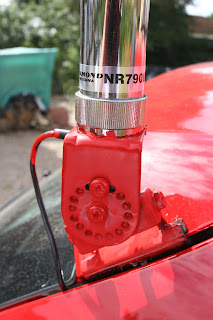The trip up to South London, from the Kent / East Sussex Border, in the new car on Friday was fine ~ but I noticed that the (usually reliable) aerial mount (antenna for our American friends) was not able to keep the aerial vertical. It had that slightly 'swept back' look about it.
 |
| Adapted Mount |
Luckily for me, that kind Radio Amateur John (M1FEL), who lives nearly 1/4-mile from me, has a grinder, drill and a selection of new BA bolts. You can see that we removed the central locknut and knurled wheel affair and, instead, used a couple of bolts. The top bolt stops the bracket from rotating (Left <> Right in the photo), which was the main problem, and the central bolt stops the bracket from coming apart.
 |
| 'Inside' of the bracket |
The aerial I am using, you may recall from a previous blog, is the Diamond dual-band NR-790. This is an excellent aerial ~ allowing me to work John over 50 miles simplex on 145.375MHz (2 metre band) despite great lumps of chalk (including Wrotham Hill) in the way! An excellent piece of kit! All I need to do now is paint the exposed metal matt black ~ probably Humbrol enamel.
 |
| Radio fitted in 'bin' below 12v supply |
The radio was, quite simply, the easiest to fit in a long while. Conveniently, the estate car has what I can only describe as 'bins' either side of the tailgate. The one on the nearside has ample room for the radio (good for circulation & cooling qualities) ~ benefiting from the cigarette-lighter socket (rated at 20 Amps) above.
 |
| Offside ~ showing aerial cable |
The other bin is not being used for any radio gear! The photo above, however, does show you how the aerial cable, mostly hidden underneath the boot space close to the spare wheel, exits the car and runs up the tailgate channel ~ eventually meeting the bracket.
 |
| Radio remote head & microphone |
The photo above shows the remote radio head in position under the Radio / CD / iPod controller. You can see the storage position of the Bluetooth headset. This configuration means that there is only one wire visible from the back of the car to the remote head. Quite neat!
 |
| The rig ~ showing the local 'natter' frequency in MHz |
If you look at the above photo closely, where the Bluetooth headset docks with the remote head (just where it says 'Dual'), you can see the blue light on the Bluetooth headset. That is showing that it is fully charged. The good thing is, even when the radio is turned off, the Bluetooth headset continues to be charged ~ showing a red LED when doing so. Clever, eh? The headset has power for just over 3 hours continual use. Good enough for me!
 |
| 'Bumper' sticker from the States |
So I am steadily getting the car the way I want it. Till next time dear friends!




































